Eco MITSUBISHI ECLIPSE CROSS 2019 Owner's Manual (in English)
[x] Cancel search | Manufacturer: MITSUBISHI, Model Year: 2019, Model line: ECLIPSE CROSS, Model: MITSUBISHI ECLIPSE CROSS 2019Pages: 423, PDF Size: 75.41 MB
Page 382 of 423
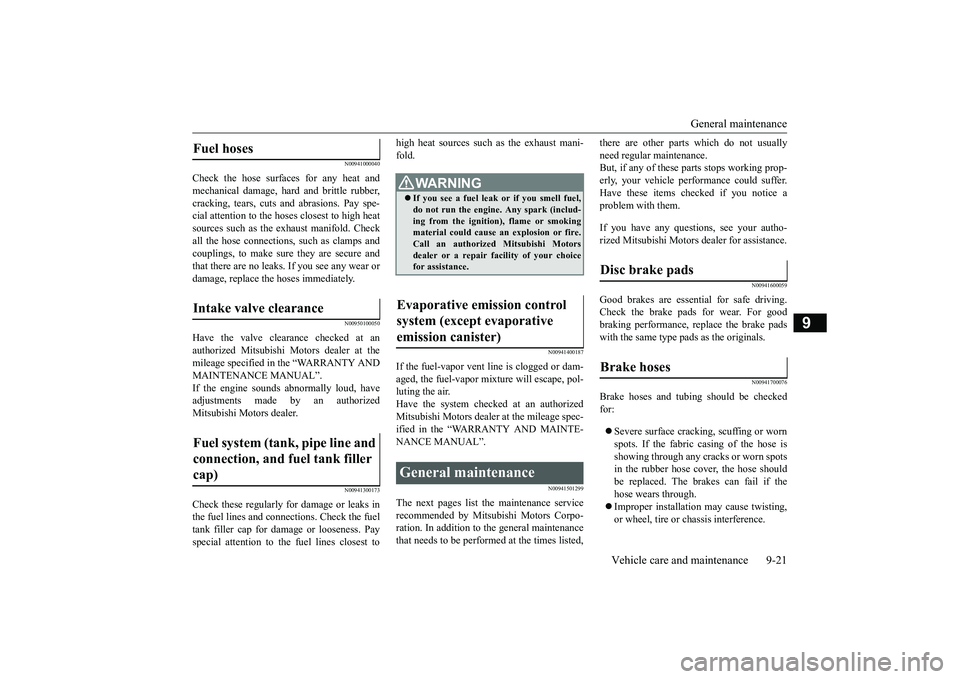
General maintenance
Vehicle care and maintenance 9-21
9
N00941000040
Check the hose surfaces for any heat and mechanical damage, hard and brittle rubber,cracking, tears, cuts and abrasions. Pay spe- cial attention to the hoses closest to high heat sources such as the exhaust manifold. Checkall the hose connections, such as clamps and couplings, to make sure they are secure and that there are no leaks. If you see any wear ordamage, replace the hoses immediately.
N00950100050
Have the valve clearance checked at anauthorized Mitsubishi Motors dealer at themileage specified in the “WARRANTY AND MAINTENANCE MANUAL”. If the engine sounds abnormally loud, haveadjustments made by an authorized Mitsubishi Motors dealer.
N00941300173
Check these regularly for damage or leaks in the fuel lines and connections. Check the fuel tank filler cap for damage or looseness. Pay special attention to the fuel lines closest to
high heat sources such as the exhaust mani- fold.
N00941400187
If the fuel-vapor vent line is clogged or dam- aged, the fuel-vapor mixture will escape, pol- luting the air.Have the system checked at an authorized Mitsubishi Motors dealer at the mileage spec- ified in the “WARRANTY AND MAINTE-NANCE MANUAL”.
N00941501299
The next pages list the maintenance servicerecommended by Mitsubishi Motors Corpo- ration. In addition to the general maintenance that needs to be perfor
med at the times listed,
there are other parts which do not usually need regular maintenance. But, if any of these parts stops working prop- erly, your vehicle performance could suffer.Have these items checked if you notice a problem with them. If you have any questions, see your autho- rized Mitsubishi Motors
dealer for assistance.
N00941600059
Good brakes are essential for safe driving. Check the brake pads for wear. For good braking performance, replace the brake padswith the same type pads as the originals.
N00941700076
Brake hoses and tubing should be checkedfor: Severe surface cracking, scuffing or worn spots. If the fabric casing of the hose is showing through any cracks or worn spotsin the rubber hose cover, the hose should be replaced. The brakes can fail if the hose wears through. Improper installation may cause twisting, or wheel, tire or chassis interference.
Fuel hoses Intake valve clearance Fuel system (tank, pipe line and connection, and fuel tank filler cap)
WA R N I N G If you see a fuel leak or if you smell fuel, do not run the engine. Any spark (includ- ing from the ignition), flame or smokingmaterial could cause an explosion or fire. Call an authorized Mitsubishi Motors dealer or a repair facility of your choicefor assistance.
Evaporative emission control system (except evaporative emission canister) General maintenance
Disc brake pads Brake hoses
BK0266800US.bo
ok 21 ページ 2018年6月27日 水曜日 午後5時6分
Page 383 of 423
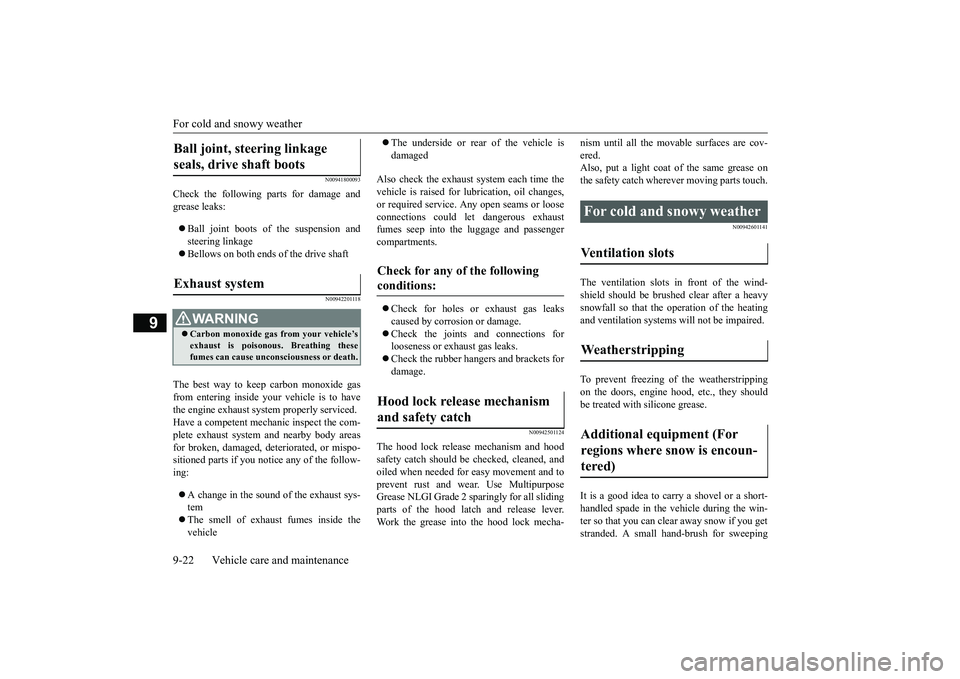
For cold and snowy weather 9-22 Vehicle care and maintenance
9
N00941800093
Check the following parts for damage and grease leaks: Ball joint boots of the suspension and steering linkage Bellows on both ends of the drive shaft
N00942201118
The best way to keep carbon monoxide gas from entering inside your vehicle is to have the engine exhaust system properly serviced. Have a competent mechanic inspect the com-plete exhaust system and nearby body areas for broken, damaged, deteriorated, or mispo- sitioned parts if you notice any of the follow-ing: A change in the sound of the exhaust sys- tem The smell of exhaust fumes inside the vehicle
The underside or rear of the vehicle is damaged
Also check the exhaust system each time the vehicle is raised for lubrication, oil changes, or required service. Any open seams or looseconnections could let dangerous exhaust fumes seep into the luggage and passenger compartments. Check for holes or exhaust gas leaks caused by corrosion or damage. Check the joints and connections for looseness or exhaust gas leaks. Check the rubber hangers and brackets for damage.
N00942501124
The hood lock release mechanism and hood safety catch should be checked, cleaned, and oiled when needed for easy movement and toprevent rust and wear. Use Multipurpose Grease NLGI Grade 2 spar
ingly for all sliding
parts of the hood latch and release lever.Work the grease into the hood lock mecha-
nism until all the movable surfaces are cov- ered. Also, put a light coat of the same grease on the safety catch wherever moving parts touch.
N00942601141
The ventilation slots in front of the wind- shield should be brushed clear after a heavy snowfall so that the operation of the heatingand ventilation systems will not be impaired. To prevent freezing of the weatherstripping on the doors, engine hood, etc., they should be treated with silicone grease. It is a good idea to carry a shovel or a short- handled spade in the vehicle during the win- ter so that you can clear away snow if you get stranded. A small hand-brush for sweeping
Ball joint, steering linkage seals, drive shaft boots Exhaust system
WA R N I N G Carbon monoxide gas from your vehicle’s exhaust is poisonous. Breathing these fumes can cause unconsciousness or death.
Check for any of the following conditions: Hood lock release mechanism and safety catch
For cold and snowy weather Ventilation slots Weatherstripping Additional equipment (For regions where snow is encoun-tered)
BK0266800US.bo
ok 22 ページ 2018年6月27日 水曜日 午後5時6分
Page 387 of 423

Fuses 9-26 Vehicle care and maintenance
9
N00954901167
1. Before replacing a fuse, always turn off the electrical item connected to the fuse and turn the ignition switch to the “OFF”position or put the operation mode in OFF. 2. There is a fuse remover (A) in the enginecompartment fuse block.
3. Clamp it on the fuse you wish to remove, and pull the fuse straight out from the fuseblock. 4. Use the fuse location diagrams and the matching tables, to check the fuse that is related to the problem. If the fuse is not blown, something else must be causingthe problem. Have the system inspectedby your authorized Mitsubishi Motors dealer or a repair facility of your choice.
5. Insert a new fuse of the same capacity securely into the appropriate slot.
Identification of fuse Capacity
Color
7.5 A Brown10 A Red15 A Blue20 A Yellow25 A Natural (white) 30 A
Green (fuse type) / Pink (fusible link type)
40 A Green (fusible link type)
Fuse replacement
B- Fuse is OK C- Blown fuseCAUTION Never use a fuse with a capacity greater than the one listed or any substitute, such as wire, foil etc. This would cause the circuit wiring to heat up and could cause a fire. If the replacement fuse blows again after a short time, have the electrical systemchecked by an authorized Mitsubishi Motors dealer or a repair faci
lity of your choice to
find and correct the cause.
BK0266800US.bo
ok 26 ページ 2018年6月27日 水曜日 午後5時6分
Page 388 of 423
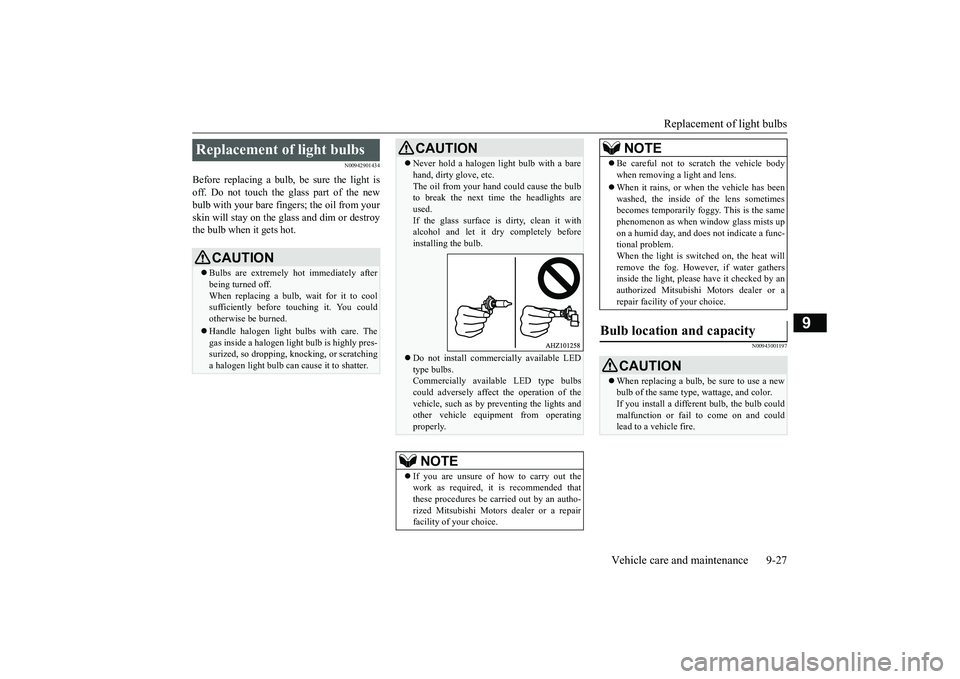
Replacement of light bulbs
Vehicle care and maintenance 9-27
9
N00942901434
Before replacing a bulb, be sure the light is off. Do not touch the glass part of the newbulb with your bare fingers; the oil from your skin will stay on the glass and dim or destroy the bulb when it gets hot.
N00943001197
Replacement of light bulbs
CAUTION Bulbs are extremely hot immediately after being turned off.When replacing a bulb, wait for it to cool sufficiently before touching it. You could otherwise be burned. Handle halogen light bulbs with care. The gas inside a halogen light bulb is highly pres-surized, so dropping, knocking, or scratching a halogen light bulb can cause it to shatter.
Never hold a halogen light bulb with a bare hand, dirty glove, etc. The oil from your hand could cause the bulb to break the next time the headlights are used.If the glass surface is dirty, clean it with alcohol and let it dry completely before installing the bulb. Do not install commercially available LED type bulbs.Commercially available LED type bulbs could adversely affect the operation of the vehicle, such as by preventing the lights andother vehicle equipment from operating properly.NOTE
If you are unsure of how to carry out the work as required, it is recommended that these procedures be carried out by an autho- rized Mitsubishi Motors dealer or a repairfacility of your choice.CAUTION
Be careful not to scratch the vehicle body when removing a light and lens. When it rains, or when the vehicle has been washed, the inside of the lens sometimesbecomes temporarily foggy. This is the same phenomenon as when window glass mists up on a humid day, and does not indicate a func-tional problem. When the light is switched on, the heat will remove the fog. However, if water gathersinside the light, please have it checked by an authorized Mitsubishi Motors dealer or a repair facility of your choice.
Bulb location and capacity
CAUTION When replacing a bulb, be sure to use a new bulb of the same type, wattage, and color.If you install a different bulb, the bulb could malfunction or fail to come on and could lead to a vehicle fire.NOTE
BK0266800US.bo
ok 27 ページ 2018年6月27日 水曜日 午後5時6分
Page 391 of 423
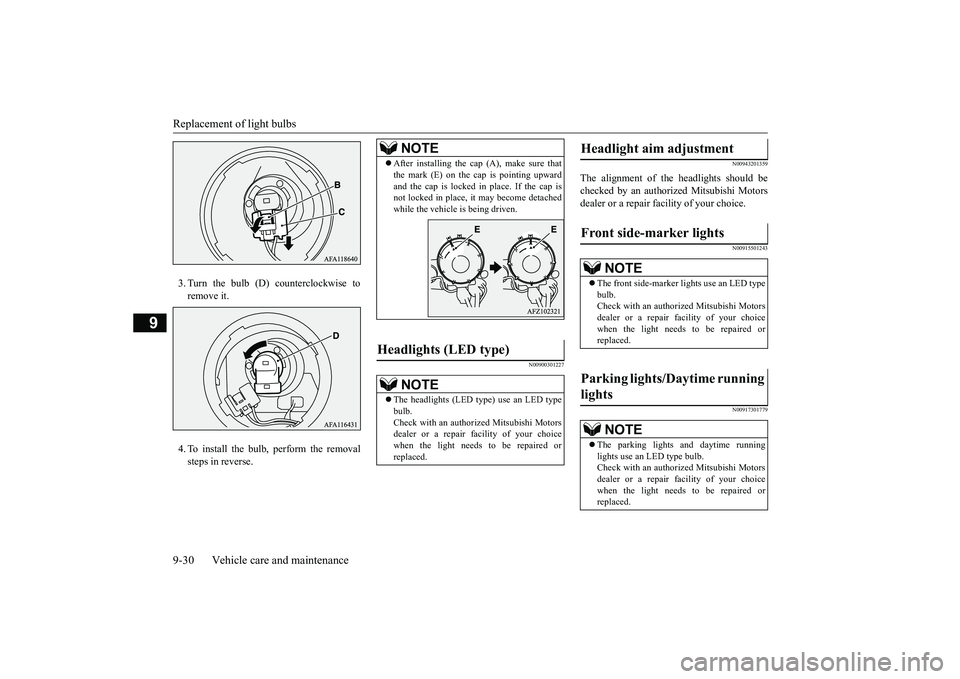
Replacement of light bulbs 9-30 Vehicle care and maintenance
9
3. Turn the bulb (D) counterclockwise to remove it. 4. To install the bulb, perform the removal steps in reverse.
N00900301227
N00943201359
The alignment of the headlights should be checked by an authorized Mitsubishi Motorsdealer or a repair facility of your choice.
N00915501243 N00917301779
NOTE
After installing the cap (A), make sure that the mark (E) on the cap is pointing upward and the cap is locked in place. If the cap is not locked in place, it may become detached while the vehicle is being driven.
Headlights (LED type)
NOTE
The headlights (LED type) use an LED type bulb. Check with an authorized Mitsubishi Motors dealer or a repair
facility of your choice
when the light needs to be repaired or replaced.
Headlight aim adjustment Front side-marker lights
NOTE
The front side-marker lights use an LED type bulb.Check with an authorized Mitsubishi Motors dealer or a repair
facility of your choice
when the light needs to be repaired orreplaced.
Parking lights/Daytime running lights
NOTE
The parking lights and daytime running lights use an LED type bulb.Check with an authorized Mitsubishi Motors dealer or a repair
facility of your choice
when the light needs to be repaired orreplaced.
BK0266800US.bo
ok 30 ページ 2018年6月27日 水曜日 午後5時6分
Page 400 of 423
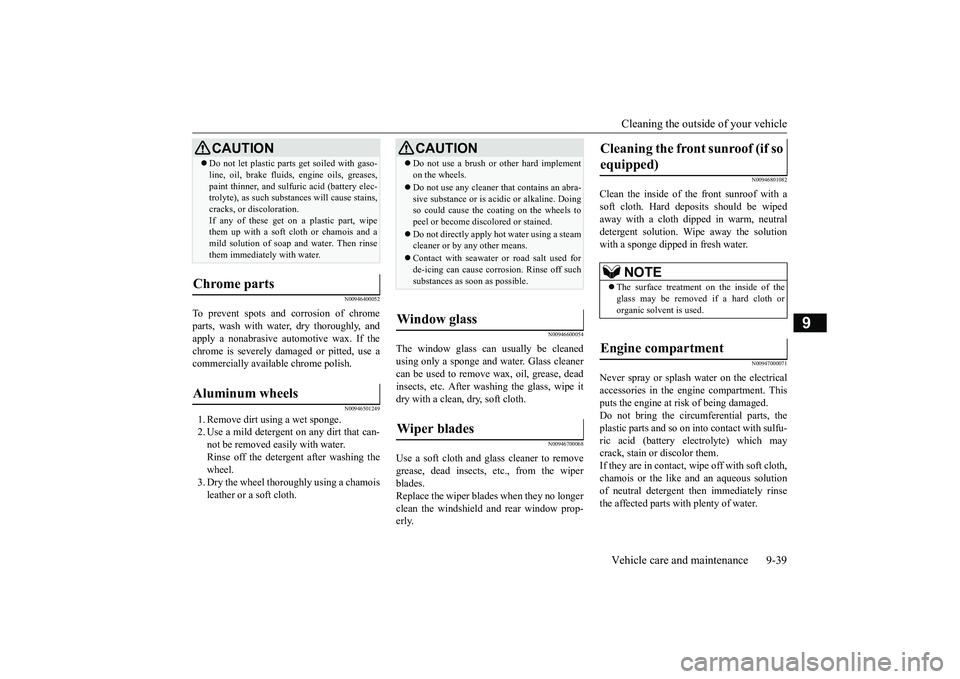
Cleaning the outside of your vehicle Vehicle care and maintenance 9-39
9
N00946400052
To prevent spots and corrosion of chrome parts, wash with water, dry thoroughly, and apply a nonabrasive automotive wax. If thechrome is severely damaged or pitted, use a commercially available chrome polish.
N00946501249
1. Remove dirt using a wet sponge.2. Use a mild detergent on any dirt that can- not be removed easily with water.Rinse off the detergent after washing the wheel. 3. Dry the wheel thoroug
hly using a chamois
leather or a soft cloth.
N00946600054
The window glass can usually be cleanedusing only a sponge and water. Glass cleaner can be used to remove wax, oil, grease, dead insects, etc. After washing the glass, wipe itdry with a clean, dry, soft cloth.
N00946700068
Use a soft cloth and glass cleaner to removegrease, dead insects, etc., from the wiper blades. Replace the wiper blades when they no longerclean the windshield and rear window prop- erly.
N00946801082
Clean the inside of the front sunroof with a soft cloth. Hard deposits should be wiped away with a cloth dipped in warm, neutral detergent solution. Wipe away the solutionwith a sponge dipped in fresh water.
N00947000071
Never spray or splash water on the electricalaccessories in the engine compartment. This puts the engine at risk of being damaged. Do not bring the circumferential parts, theplastic parts and so on into contact with sulfu- ric acid (battery electrolyte) which may crack, stain or discolor them.If they are in contact, wipe off with soft cloth, chamois or the like and an aqueous solution of neutral detergent then immediately rinsethe affected parts with plenty of water.
Do not let plastic parts get soiled with gaso- line, oil, brake fluids
, engine oils, greases,
paint thinner, and sulfuric acid (battery elec- trolyte), as such substances will cause stains, cracks, or discoloration.If any of these get on a plastic part, wipe them up with a soft cloth or chamois and a mild solution of soap and water. Then rinsethem immediately with water.
Chrome parts Aluminum wheels
CAUTION
CAUTION Do not use a brush or other hard implement on the wheels. Do not use any cleaner that contains an abra- sive substance or is acidic or alkaline. Doingso could cause the coating on the wheels to peel or become discolored or stained. Do not directly apply hot water using a steam cleaner or by any other means. Contact with seawater or road salt used for de-icing can cause corrosion. Rinse off such substances as soon as possible.
Window glass Wiper blades
Cleaning the front sunroof (if so equipped)
NOTE
The surface treatment on the inside of the glass may be removed if a hard cloth or organic solvent is used.
Engine compartment
BK0266800US.bo
ok 39 ページ 2018年6月27日 水曜日 午後5時6分
Page 404 of 423
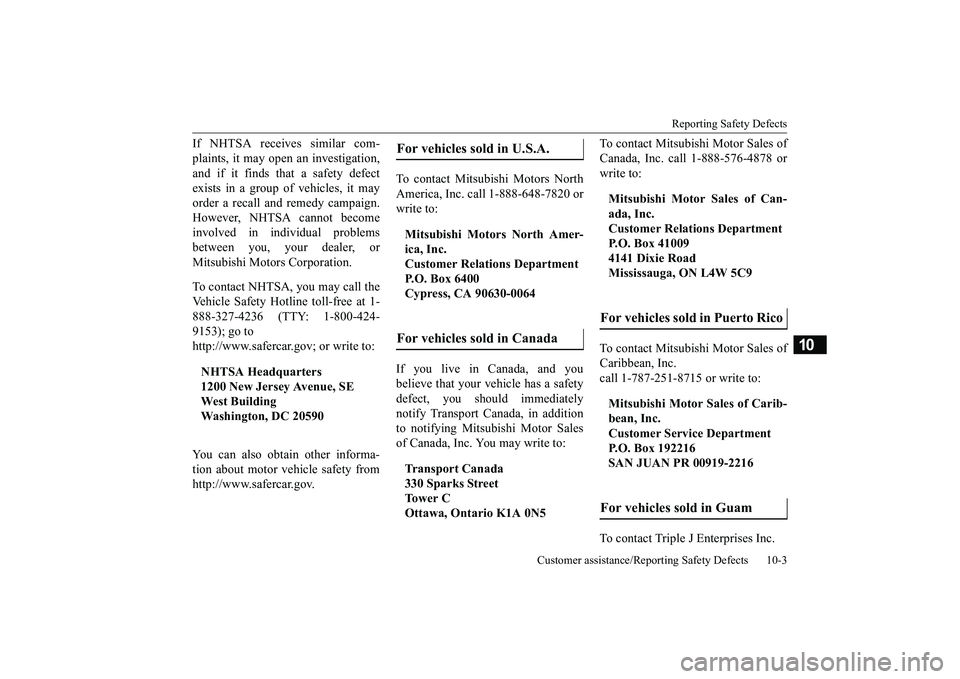
Reporting Safety Defects
Customer assistance/Reporting Safety Defects 10-3
10
If NHTSA receives similar com- plaints, it may open an investigation, and if it finds that a safety defect exists in a group of vehicles, it may order a recall and remedy campaign.However, NHTSA cannot become involved in individual problems between you, your dealer, orMitsubishi Motors Corporation. To contact NHTSA, you may call the Vehicle Safety Hotline toll-free at 1- 888-327-4236 (TTY: 1-800-424- 9153); go tohttp://www.safercar.gov; or write to: You can also obtain other informa- tion about motor vehicle safety from http://www.safercar.gov.
To contact Mitsubishi Motors North America, Inc. call 1-888-648-7820 or write to: If you live in Canada, and you believe that your vehicle has a safety defect, you should immediately notify Transport Canada, in additionto notifying Mitsubishi Motor Sales of Canada, Inc. You may write to:
To contact Mitsubishi Motor Sales of Canada, Inc. call 1-888-576-4878 or write to: To contact Mitsubishi Motor Sales of Caribbean, Inc. call 1-787-251-8715 or write to: To contact Triple J Enterprises Inc.
NHTSA Headquarters 1200 New Jersey Avenue, SE West BuildingWashington, DC 20590
For vehicles sold in U.S.A. Mitsubishi Motors North Amer-ica, Inc.Customer Relations Department P.O. Box 6400 Cypress, CA 90630-0064For vehicles sold in Canada Transport Canada330 Sparks Street To w e r C Ottawa, Ontario K1A 0N5
Mitsubishi Motor Sales of Can- ada, Inc. Customer Relations DepartmentP.O. Box 41009 4141 Dixie Road Mississauga, ON L4W 5C9For vehicles sold in Puerto Rico Mitsubishi Motor Sales of Carib-bean, Inc.Customer Service Department P.O. Box 192216 SAN JUAN PR 00919-2216For vehicles sold in Guam
BK0266800US.bo
ok 3 ページ 2018年6月27日 水曜日 午後5時6分
Page 405 of 423
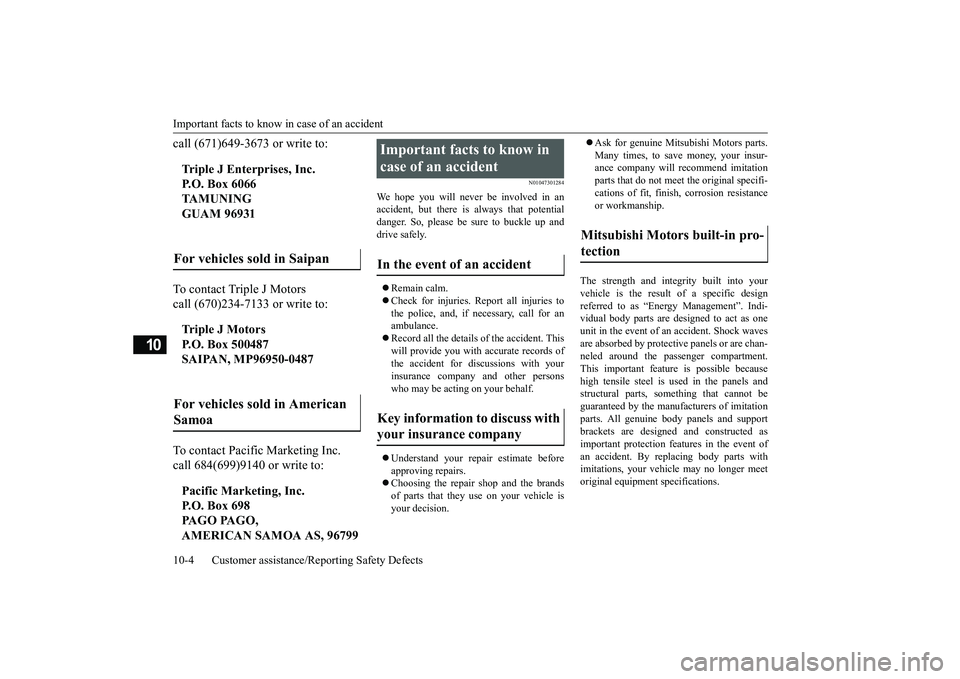
Important facts to know in case of an accident 10-4 Customer assistance/Reporting Safety Defects
10
call (671)649-3673 or write to: To contact Triple J Motors call (670)234-7133 or write to: To contact Pacific Marketing Inc. call 684(699)9140 or write to:
N01047301284
We hope you will never be involved in an accident, but there is always that potentialdanger. So, please be sure to buckle up and drive safely. Remain calm. Check for injuries. Report all injuries to the police, and, if necessary, call for an ambulance. Record all the details of the accident. This will provide you with accurate records of the accident for discussions with your insurance company and other personswho may be acting on your behalf. Understand your repair estimate before approving repairs. Choosing the repair
shop and the brands
of parts that they use on your vehicle isyour decision.
Ask for genuine Mitsubishi Motors parts. Many times, to save money, your insur- ance company will recommend imitation parts that do not meet the original specifi-cations of fit, finish, corrosion resistance or workmanship.
The strength and integrity built into your vehicle is the result of a specific design referred to as “Energy Management”. Indi-vidual body parts are designed to act as one unit in the event of an accident. Shock waves are absorbed by protective panels or are chan-neled around the passenger compartment. This important feature is possible because high tensile steel is used in the panels andstructural parts, something that cannot be guaranteed by the manufacturers of imitation parts. All genuine body panels and supportbrackets are designed and constructed as important protection features in the event of an accident. By replacing body parts withimitations, your vehicle may no longer meet original equipment specifications.
Triple J Enterprises, Inc. P.O. Box 6066 TAMUNING GUAM 96931For vehicles sold in Saipan Triple J Motors P.O. Box 500487 SAIPAN, MP96950-0487For vehicles sold in American Samoa Pacific Marketing, Inc. P.O. Box 698 PAGO PAGO, AMERICAN SAMOA AS, 96799
Important facts to know in case of an accident In the event of an accident Key information to discuss with your insurance company
Mitsubishi Motors built-in pro- tection
BK0266800US.bo
ok 4 ページ 2018年6月27日 水曜日 午後5時6分
Page 409 of 423
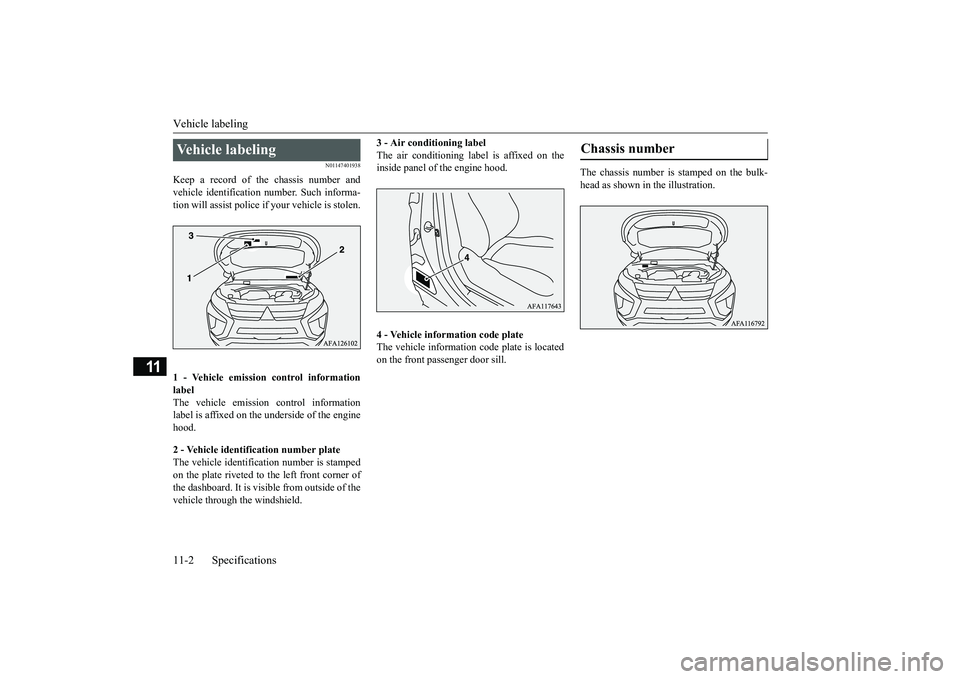
Vehicle labeling 11-2 Specifications
11
N01147401938
Keep a record of the chassis number and vehicle identification number. Such informa-tion will assist police if your vehicle is stolen. 1 - Vehicle emission control information label The vehicle emission control informationlabel is affixed on the underside of the engine hood. 2 - Vehicle identification number plate The vehicle identification number is stampedon the plate riveted to the left front corner of the dashboard. It is visible from outside of the vehicle through the windshield.
3 - Air conditioning label The air conditioning label is affixed on the inside panel of the engine hood. 4 - Vehicle information code plate The vehicle information code plate is locatedon the front passenger door sill.
The chassis number is stamped on the bulk- head as shown in the illustration.
Vehicle labeling
Chassis number
BK0266800US.bo
ok 2 ページ 2018年6月27日 水曜日 午後5時6分
Page 417 of 423
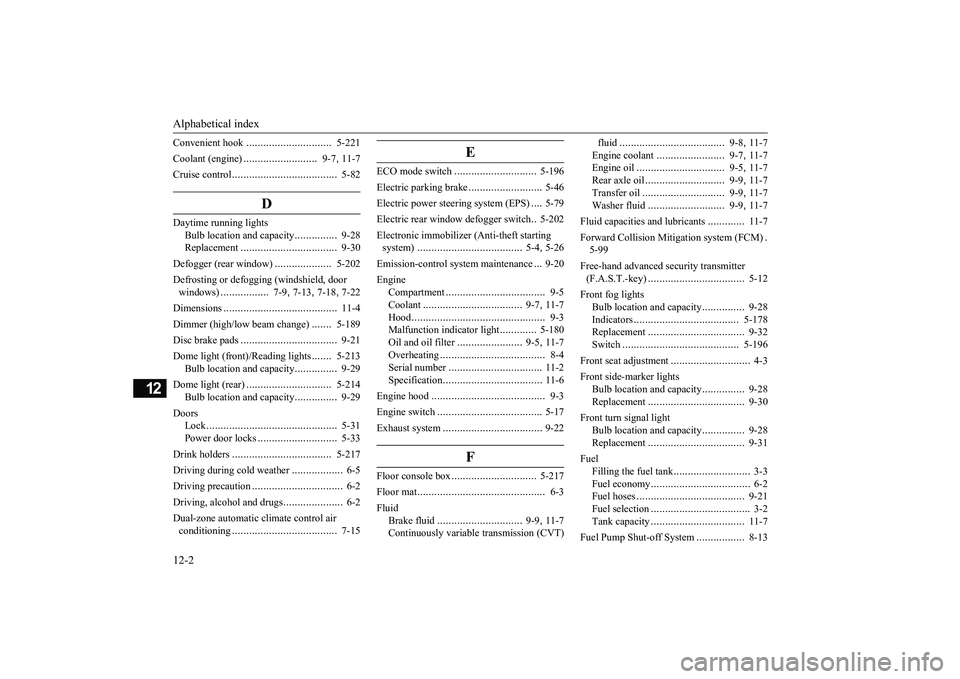
Alphabetical index 12-2
12
Convenient hook
...............
...............
5-221
Coolant (engine)
..........................
9-7
, 11-7
Cruise control
....................
.................
5-82
D
Daytime running lights
Bulb location and capacity
...............
9-28
Replacement
.................
.................
9-30
Defogger (rear window)
....................
5-202
Defrosting or defogging (windshield, door windows)
.................
7-9
, 7-13
, 7-18
, 7-22
Dimensions
...................
.....................
11-4
Dimmer (high/low beam change)
.......
5-189
Disc brake pads
.................
.................
9-21
Dome light (front)/Reading lights
.......
5-213
Bulb location and capacity
...............
9-29
Dome light (rear)
...............
...............
5-214
Bulb location and capacity
...............
9-29
Doors
Lock
......................
........................
5-31
Power door locks
............................
5-33
Drink holders
....................
...............
5-217
Driving during cold weather
..................
6-5
Driving precaution
................
................
6-2
Driving, alcohol and drugs
.....................
6-2
Dual-zone automatic climate control air conditioning
....................
.................
7-15
E
ECO mode switch
.............................
5-196
Electric parking brake
..........................
5-46
Electric power steering system (EPS)
....
5-79
Electric rear window defogger switch
..5-202
Electronic immobilizer (Anti-theft starting system)
.....................
................
5-4
, 5-26
Emission-control system maintenance
...
9-20
Engine
Compartment
..................
.................
9-5
Coolant
...................
................
9-7
, 11-7
Hood
.......................
........................
9-3
Malfunction indicator light
.............
5-180
Oil and oil filter
.......................
9-5
, 11-7
Overheating
....................
.................
8-4
Serial number
.................
................
11-2
Specification
...................
................
11-6
Engine hood
....................
....................
9-3
Engine switch
.....................
................
5-17
Exhaust system
...................
................
9-22
F
Floor console box
..............................
5-217
Floor mat
.........................
....................
6-3
Fluid
Brake fluid
..............................
9-9
, 11-7
Continuously variable transmission (CVT)
fluid
....................
.................
9-8
, 11-7
Engine coolant
........................
9-7
, 11-7
Engine oil
...............................
9-5
, 11-7
Rear axle oil
............................
9-9
, 11-7
Transfer oil
.............................
9-9
, 11-7
Washer fluid
...........................
9-9
, 11-7
Fluid capacities and lubricants
.............
11-7
Forward Collision Mitigation system (FCM)
.
5-99 Free-hand advanced security transmitter (F.A.S.T.-key)
.................
.................
5-12
Front fog lights
Bulb location and capacity
...............
9-28
Indicators
..................
...................
5-178
Replacement
.................
.................
9-32
Switch
......................
...................
5-196
Front seat adjustment
............................
4-3
Front side-marker lights
Bulb location and capacity
...............
9-28
Replacement
.................
.................
9-30
Front turn signal light
Bulb location and capacity
...............
9-28
Replacement
.................
.................
9-31
Fuel
Filling the fuel tank
...........................
3-3
Fuel economy
...................
................
6-2
Fuel hoses
.....................
.................
9-21
Fuel selection
...................
................
3-2
Tank capacity
................
.................
11-7
Fuel Pump Shut-off System
.................
8-13
BK0266800US.bo
ok 2 ページ 2018年6月27日 水曜日 午後5時6分